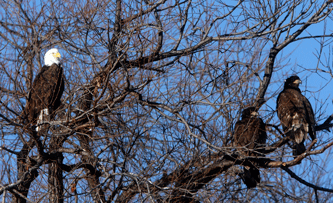Migration to the Basin
Dave Menke of the Klamath National Wildlife Refuges said he has seen 30 or so eagles along the Lower Klamath refuge auto tour route, and lesser numbers on the Tule Lake refuge. He believes those numbers probably represent about 30 to 50 percent of the eagles on the refuges and in the region.
Menke said it’s common to see a dozen or more in trees along the Lower Klamath auto tour route.
“Due to the ice covering most of the water units on the two refuges, there appear to be few waterfowl here compared to some years past,” he said. “With the thawing we may see a resurgence in numbers.”
Ralph Opp, a retired biologist,
said the thawing should help distribute eagle
populations, which he believes have been
concentrated on the open waters of Lake Ewauna.
“They go where the food is,” he said.
During winter, eagles feed on dead or weakened
waterfowl.
Opp said winter populations of bald eagles
typically range from 600 to 800 in late January
and early February, although upward of 1,000
have been counted some years.

